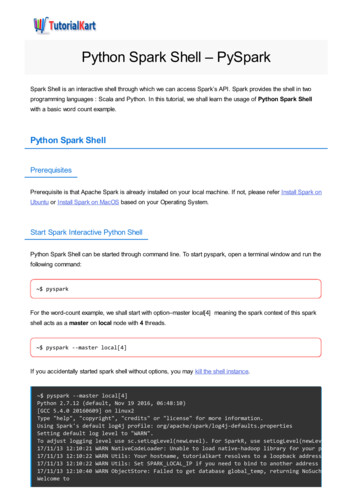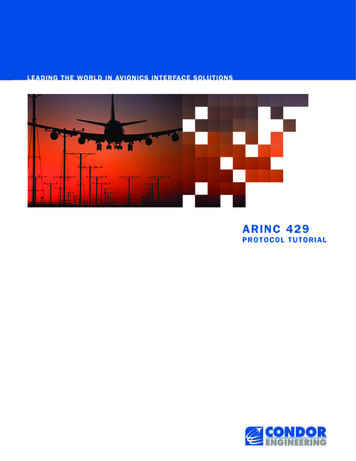
Transcription
CopyrightsCopyright 2000-2004 Condor Engineering, Inc.All rights reserved.This document may not, in whole or part, be; copied; photocopied; reproduced; translated;reduced or transferred to any electronic medium or machine-readable form without priorconsent in writing from Condor Engineering, Inc.ARINC Protocol Tutorial (1500-029)Document Date: 16 July, 2004Document Revision:1.07Condor Engineering, Inc.101 W. Anapamu StreetSanta Barbara, CA 93101(805) 965-8000(805) 963-9630 (fax)support@condoreng.com (email)http://www.condoreng.com
Contents and TablesContentsChapter 1ARINC 429 TutorialIntroduction. 1About ARINC. 2What is ARINC 429? . 2ARINC 429 Usage . 3ARINC 429 Electrical Characteristics . 3Protocol . 5Bit Timing and Slew Rate. 6ARINC 429 Word Format. 7Parity. 7SSM . 7Data. 8SDI. 8Label . 8Transmission Order. 8ARINC 429 Data Types . 9BCD Data Encoding. 9BNR Data Encoding. 9Mixed Formats .10Discrete Data Formats.11Maintenance Data.12Data Translation Method.12Bit Oriented Protocols .15Chapter 2Other ARINC ProtocolsARINC 419.19ARINC 453.20ARINC 561/568.20ARINC 573.20ARINC 575.21ARINC 582.21ARINC Protocol Tutoriali
ARINC 615.21ARINC 629.22ARINC 708.22ARINC 717.22Appendix AReferencesList of References . 23Table of FiguresFigure 1. ARINC 429 Bit Encoding Example .5Figure 2. Slew Rates and Bit Timing Diagram.6Figure 3. Generalized ARINC Word Format.7Figure 4. Generalized BCD Word Format .9Figure 5. BCD Word Format Example .9Figure 6. Generalized BNR Word Format .10Figure 7. Example BNR Encoding.10Figure 8. File Transfer Scheme Version 1 (no Windows).16Figure 9. ARINC 561 6-Wire Bit Encoding .20Figure 10. Harvard Bi-phase Bit Encoding.21List of TablesTable 1. Partial List of Equipment IDs .4Table 2. ARINC 429 Characteristic Summary .5Table 3. ARINC Bit Characteristics.6Table 4. SSM Codes for BCD data .7Table 5. SSM Codes for BNR data .7Table 6. Dedicated Discrete Example .11Table 7. Examples of BCD Labels.13Table 8. Examples of BNR Labels.13Table 9. Equipment IDs for Tables 6 and 7 .13Table 10. Message Sequence for Label 241 .14Table 11. Systems Using Bit Oriented Communicationsand Their Address Labels.17iiARINC Protocol Tutorial
CHAPTER1ARINC 429 TutorialIntroductionThis document provides an overview of ARINC 429 and other ARINCprotocols. ARINC 429 is the most commonly used data bus forcommercial and transport aircraft. This document explains the origins ofthe ARINC Corporation, the data bus specification and where ARINC 429is used. Then it summarizes the principal electrical and datacharacteristics, which are defined in the specification.This document is not a complete description of ARINC 429. It is intendedonly as a brief tutorial and isn’t meant to replace the completespecification, which can be purchased from ARINC (see Appendix A,“References” for contact information).ARINC 429 employs unidirectional transmission of 32 bit words over twowire twisted pairs using bipolar RZ format. This tutorial includes chartsillustrating slew times and bit timing. It describes the five fields in eachword and explains the use of labels. Messages are repeated at specifiedintervals with typical applications sending groups or frames of messages.Examples are given of the commonly used word formats such as BNR,BCD, Discrete data, and other formats. Also explained is a newer bitoriented protocol, sometimes called the Williamsburg Protocol, which hasbeen introduced to provide an improved method of transmitting files ofdata. Additionally, the document includes a brief explanation of otherARINC specifications, such as 419, 561, 573, 582, 615, and 717.Frequent references are made to ARINC Specification 429 and manyexamples are taken from it. This tutorial is intended to introduce you to thesubject. Individuals needing more detail should obtain a copy of thespecification from ARINC and also should consider consulting othersources identified in the list of references.This document has been prepared by Condor Engineering Incorporated foruse by its employees and customers. Condor is a full-service manufacturerof Test, Simulation, and Interface products for avionics data buses. TheARINC Protocol Tutorial1
About ARINCARINC 429 Tutorialhardware and software can be used to monitor or simulate data busmessages for analyses and for simulating bus operation. To learn about thefull line of Condor products, visit our Web site or contact us by phone orfax. Information can also be obtained via e-mail. See the Copyrights pageof this manual for the latest contact information. Detailed installation anduser manuals are provided with each product, and demonstration softwareis available free of charge.About ARINCAeronautical Radio, Incorporated (ARINC) is a major company thatdevelops and operates systems and services to ensure the efficiency,operation, and performance of the aviation and travel industries. It wasorganized in 1929 by four major airlines to provide a single licensee andcoordinator of radio communications outside the government. Onlyairlines and aviation-related companies can be shareholders, although allairlines and aircraft can use ARINC’s services. It is now a 280 millioncompany with headquarters in Annapolis, Maryland and over 50 operatinglocations worldwide. The company has two major thrusts: Communications and information processing services for the aviationand travel industry. System engineering, development and integration for government andindustry.ARINC has provided leadership in developing specifications and standardsfor avionics equipment, and one of these specifications is the focus of thistutorial. Industry-wide committees prepare the specifications andstandards. ARINC Specification 429 was developed and is maintained bythe Airlines Electronic Engineering Committee (AEEC) comprisingmembers that represent airlines, government, and ARINC.The General Aviation Manufacturers Association (GAMA) in Washington,D.C. also maintains a specification document with ARINC 429 labels:“ARINC 429 General Aviation Subset”.What is ARINC 429?ARINC 429 is a specification, which defines how avionics equipment andsystems should communicate with each other. They are interconnected bywires in twisted pairs. The specification defines the electrical and datacharacteristics and protocols, which are used. ARINC 429 employs aunidirectional data bus standard known as Mark 33 Digital InformationTransfer System (DITS). Messages are transmitted at a bit rate of either12.5 or 100 kilobits per second to other system elements, which aremonitoring the bus messages. Transmission and reception is on separate2ARINC Protocol Tutorial
ARINC 429 TutorialARINC 429 Electrical Characteristicsports so that many wires may be needed on aircraft, which use a largenumber of avionics systems.ARINC 429 UsageARINC 429 has been installed on most commercial transport aircraftincluding; Airbus A310/A320 and A330/A340; Bell Helicopters; Boeing727, 737, 747, 757, and 767; and McDonnell Douglas MD-11. Boeing isinstalling a newer system specified as ARINC 629 on the 777, and someaircraft are using alternate systems in an attempt to reduce the weight ofwire needed and to exchange data at a higher rate than is possible withARINC 429. The unidirectional ARINC 429 system provides highreliability at the cost of wire weight and limited data rates. Military aircraftgenerally use a high-speed, bi-directional protocol specified in MilitarySpecifications MIL-STD-1553.Each aircraft may be equipped with different electronic equipment andsystems needing interconnection. A large amount of equipment may beinvolved depending on the aircraft. These are identified in thespecification and are assigned digital identification numbers calledEquipment ID. A partial list of equipment identified in ARINCSpecification 429-15 can be found in Table 1 along with their digitaladdresses.The specification also identifies a number of systems, which are capable ofinterchanging files of data in a bit-oriented format. Such files may requirethe transmission of a number of messages in sequence. Systems capable ofbit-oriented communications and their addresses are listed in Table 10.The SAL is used to identify the recipient of a bit oriented message.ARINC 429 Electrical CharacteristicsAn ARINC 429 data bus uses two signal wires to transmit 32 bit words.Transmission of sequential words is separated by at least 4 bit times ofNULL (zero voltage). This eliminates the need for a separate clock signalwire. That’s why this signal is known as a self-clocking signal.The nominal transmission voltage is 10 1 volts between wires(differential), with either a positive or negative polarity. Therefore, eachsignal leg ranges between 5V and -5V. If one leg is 5V, the other is -5Vand vice versa. One wire is called the “A” (or “ ” or “HI”) side and theother is the “B” (or “-” or “LO”) side. This is known as bipolar return-tozero (BPRZ) modulation. The composite signal state may be one of threelevels: ARINC Protocol TutorialHI which should measure between 7.25 and 11 volts between the twowires (A to B).3
ARINC 429 Electrical CharacteristicsARINC 429 Tutorial NULL which should be between 0.5 and -0.5 (A to B). LO which should be between -7.25 and -11 volts (A to B).The received voltage depends on line length and the number of receiversconnected to the bus. No more than 20 receivers should be connected to asingle bus. Since each bus is unidirectional, a system needs to have its owntransmit bus if it is required to respond or to send messages.Table 1. Partial List of Equipment IDsEq. IDEquipment TypeEq. IDEquipment Type001Flight Control Computer (701)029ADDCS (729) and EICAS002Flight Management Computer (702)02AThrust Management Computer003Thrust Control Computer (703)02BPerf. Nav. Computer System (Boeing 737)004Inertial Reference System (704)02CDigital Fuel Gauging System (A310)005Attitude and Heading Ref. System (705) 02DEPR Indicator (Boeing 757)006Air Dat
ARINC 429 Tutorial ARINC 429 Electrical Characteristics ports so that many wire number of avionics system s may be needed on aircraft, which use a large s. ARINC 429 Usage ARINC 429 has been installed on most commercial transport aircraft including; Airbus A310/A320 and A330/A340; Bell Helicopters; Boein 727, 737, 747, 757, and 767; and McDonnell Douglas MD-11. Boei installing a

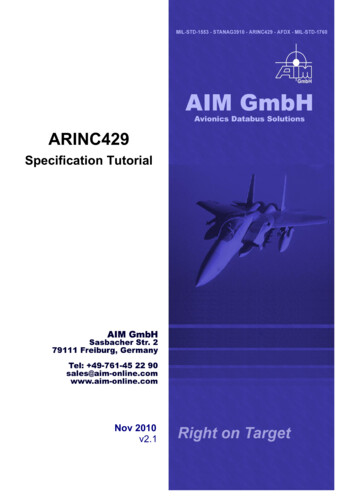
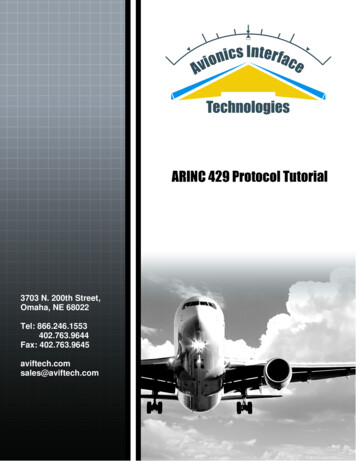

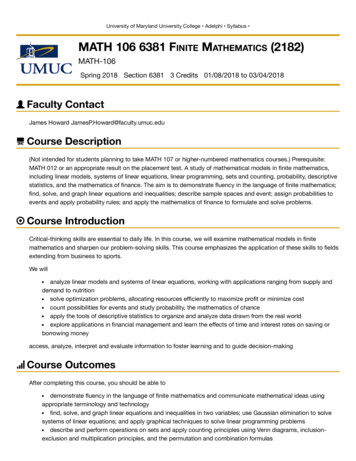
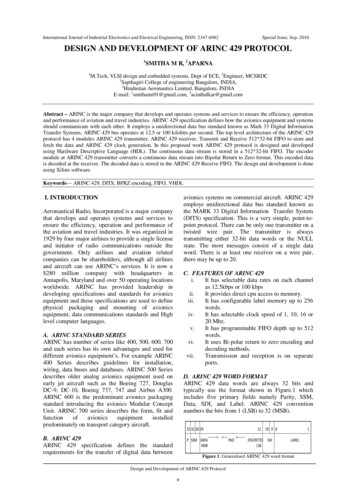
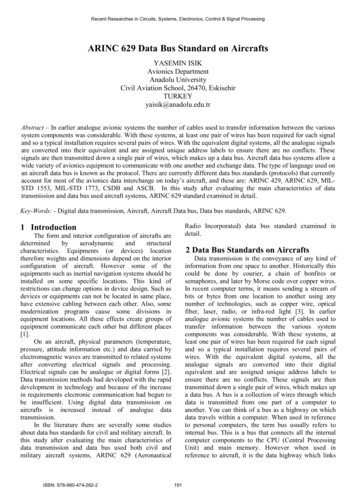
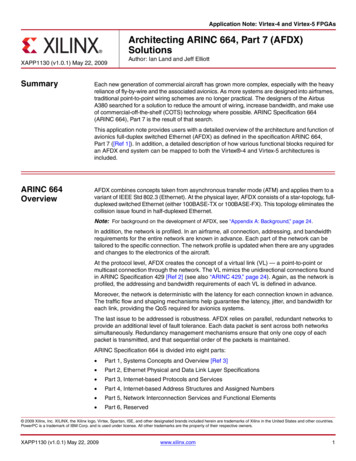
![Unreal Engine 4 Tutorial Blueprint Tutorial [1] Basic .](/img/5/ue4-blueprints-tutorial-2018.jpg)

